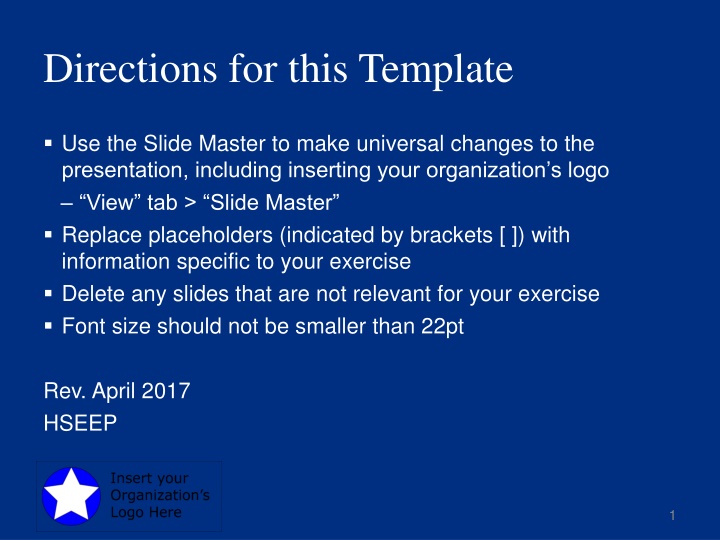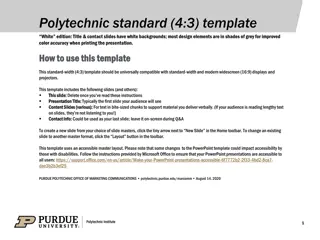Directions for this Template
Conduct a tabletop exercise to test the repopulation of campuses during the COVID-19 pandemic at Institutes of Higher Education. The briefing includes administrative items, safety protocols, operational security measures, exercise schedule, objectives, and core capabilities to examine and discuss health monitoring in the campus environment.
Uploaded on Feb 25, 2025 | 1 Views
Download Presentation

Please find below an Image/Link to download the presentation.
The content on the website is provided AS IS for your information and personal use only. It may not be sold, licensed, or shared on other websites without obtaining consent from the author.If you encounter any issues during the download, it is possible that the publisher has removed the file from their server.
You are allowed to download the files provided on this website for personal or commercial use, subject to the condition that they are used lawfully. All files are the property of their respective owners.
The content on the website is provided AS IS for your information and personal use only. It may not be sold, licensed, or shared on other websites without obtaining consent from the author.
E N D
Presentation Transcript
Directions for this Template Use the Slide Master to make universal changes to the presentation, including inserting your organization s logo View tab > Slide Master Replace placeholders (indicated by brackets [ ]) with information specific to your exercise Delete any slides that are not relevant for your exercise Font size should not be smaller than 22pt Rev. April 2017 HSEEP 1
Institutes of Higher Education COVID 19 Tabletop Exercise Exercise Briefing [Date]
Welcome and Overview [Name] [Title (e.g., Exercise Director or Lead Planner)] [Organization] Administrative Items/Safety Exits Restrooms Rally Point Cell Phones 3
Operational Security This briefing contains exercise and operational material that must be safeguarded. The materials in this briefing are categorized as For Official Use Only.
Exercise Schedule Registration Welcome and Overview of Objectives Module 1: Faculty and Staff Return Break Module 2: Students Return and Classes Resume at University X, a student Becomes ill [Time] Lunch Module 3: Additional Cases Reported, Contact Tracing Intensifies Hot Wash Closing Comments [Time] [Time] [Time] [Time] [Time] [Time] [Time] 5
Exercise Overview Exercise scope: Exercise Type: Tabletop Exercise Duration: Location: Exercise Parameters: Mission area(s): Response
Exercise Purpose This exercise is designed for Institutes of Higher Education (IHE) to test the repopulation of campuses during the COVID 19 pandemic. 7
Objectives and Core Capabilities Objective 1: Examine the ability of IHE to conduct repopulation of campuses. Aligns to Objective 2: Discuss the monitoring of health conditions to detect COVID-19 infection in the campus environment. Aligns to 8
Objectives and Core Capabilities Objective 3: Assess the ability of IHE to perform containment to prevent spread of the COVID-19 when detected. Aligns to Objective 4: Discuss the considerations for shutdown if necessitated by severe conditions in accordance with public health guidance. Aligns to 9
Participant Roles and Responsibilities Players: Players are personnel who have an active role in discussing or performing their regular roles and responsibilities during the exercise. Players discuss or initiate actions in response to the simulated emergency. Observers: Observers do not directly participate in the exercise. However, they may support the development of player responses to the situation during the discussion by asking relevant questions or providing subject matter expertise. Facilitators: Facilitators provide situation updates and moderate discussions. They also provide additional information or resolve questions as required. Key Exercise Planning Team members also may assist with facilitation as subject matter experts (SMEs) during the exercise. Evaluators: Evaluators are assigned to observe and document certain objectives during the exercise. Their primary role is to document player discussions, including how and if those discussions conform to plans, polices, and procedures. 10
Exercise Structure Module 1: Faculty and staff return Module 2: Students return and classes resume at University X, a student becomes ill Module 3: Additional cases reported, contact tracing intensifies After the updates, participants review the situation and engage a functional group discussion of appropriate response issues. 11
Exercise Guidelines This exercise will be held in an open, low-stress, no-fault environment. Varying viewpoints, even disagreements, are expected. Respond to the scenario using your knowledge of current plans and capabilities (i.e., you may use only existing assets) and insights derived from your planning and training. Decisions are not precedent setting and may not reflect your organization s final position on a given issue. This exercise is an opportunity to discuss and present multiple options and possible solutions. Issue identification is not as valuable as suggestions and recommended actions that could improve prevention, protection, mitigation, response, and recovery efforts. Problem-solving efforts should be the focus. 12
Assumptions and Artificialities The exercise is conducted in a no-fault learning environment wherein capabilities, plans, systems, and processes will be evaluated. The exercise scenario is plausible, and events occur as they are presented. All players receive information at the same time. Preparedness efforts across IHE s may differ. COVID-19 will still remain a Public Health concern until a vaccine is developed 13
IHE COVID 19 Primer As the COVID-19 outbreak continues across the United States, University X has been planning throughout the Spring and early Summer for the return to campus of students, faculty, and staff to begin the Fall semester. 14
IHE COVID 19 Primer Having suspended in-person instruction and closed on-campus housing at the end of the 2020 Spring semester due to COVID-19, campus leadership has developed plans to allow students to return to campus for the Fall 2020 semester with the following general conditions/guidelines: Students may return to either on-campus or off-campus housing. Students who live in on- campus housing must adhere to strict social distancing and respiratory etiquette protocols (e.g. no large gatherings, avoidance of common areas/lounges/dining commons, use of cloth face coverings in public areas, and increased environmental cleaning of living quarters) and students who live off campus have been encouraged to follow similar social distancing guidelines. Large events and gatherings have been cancelled or postponed for the time being and members of the University X community have been encouraged to practice social distancing as much as is practical. Classes are being held using a mixed model of both in-person and online instruction. Online instruction is prioritized where possible and when classes meet in person, social distancing measures (e.g., spacing of desks 6 feet or greater apart, use of cloth face coverings, etc.) are employed. Class sizes have been reduced where possible to reduce crowding in classrooms, lecture halls, and labs. Staff have returned to work as needed if teleworking is not feasible for their scope of duties. Similar social distancing and masking requirements have been instituted for all UNVERSITY X employees. Faculty and staff are beginning to return to campus in late July, and students are expected to arrive in mid-August. 15
Module 1: Faculty and Staff Return Faculty return to campus in late July, approximately two weeks before students are expected to return to campus and begin classes. An administrative assistant for the Geology department returns to work along with other faculty members. On her fourth day back at work, she develops a fever and cough shortly after returning from her lunch break and is sent home according to newly revised campus student/employee health protocols for those with COVID-19-like illness. 16
Module 1: Faculty and Staff Return After visiting her doctor and being tested, it is determined the employee is positive for COVID-19. Her illness is mild and she is able to recover at home while in isolation. The employee reports her illness and positive lab result to her department supervisor who immediately reports her diagnosis to University X leadership. 17
Module 1: Faculty and Staff Return The ill staff member is cooperative when asked to report where she had been during her infectious period (when she was possibly able to transmit COVID-19 to others), and consents to health department investigators sharing her diagnosis with her possible contacts in an attempt to identify others who might have been exposed, enroll them into contact monitoring, and reduce the risk of any contacts who become ill from spreading COVID-19. As faculty members had only just begun to report for work, it is determined the case-patient likely exposed only 10-12 faculty and staff members within her department. 18
Module 1: Questions Based on the information provided, participate in the discussion concerning the issues raised in Module 1 1. Given that a staff member has tested positive, what are the next steps/protocols that should be followed by University X? 2. When should the local health department be notified about the case? Who will make the notification and what information about the staff member s illness can be shared with the health department? Who will be the primary person/entity responsible for communicating/liaising with the health department? 3. What information can be shared by the University community when talking with the health department? What information can the health department share with the University? 4. How will staff from University X and local health department staff work together to perform contact tracing (exposure notification and monitoring of contacts)? 5. What information about the staff member s illness can be shared with the University X community during case investigation/contact tracing activities in order to achieve the goal of transparency that University X seeks to maintain about COVID-19 cases in the University community? 6. What information can/cannot be shared with the University community regarding the employee and her illness as contact tracing efforts are conducted? 7. Where will contacts be referred when/if they need medical evaluation or testing? What costs, if any are incurred, will be paid for/reimbursed by University X? 19
Module 2: Students Return and Classes Resume at University X, a Student becomes Ill Just over two weeks have passed since the staff member in the Geology department tested positive for COVID-19. University X leadership, in close partnership with the local health department, have worked diligently to perform contact tracing and monitoring. Only the spouse of the ill staff member has tested positive for COVID-19 and since he was a known contact, he had been in quarantine well before his illness started and did not spread COVID-19 to others. Like his spouse, his illness was mild and he has recovered. No other instances of COVID-19-like illness have been reported among faculty or staff, despite extensive screening procedures that were enacted after the initial case was reported. 21
Module 2: Students Return and Classes Resume at University X, a Student becomes Ill Students begin to return to campus and the surrounding community. Off campus students have been moving in over the past few weeks and campus residence halls conducted a staggered move-in over a two- week period to allow for additional social distancing. Orientation activities were conducted virtually prior to the arrival of students on campus in order to avoid large gatherings of students and orientation advisors. Students have been largely compliant with social distancing measures during move-in/prior to the start of classes, but the University X Office of Student Affairs has received multiple reports from concerned parents and community members that students have congregated in large numbers at private off-campus residences and on the outdoor patios of certain local restaurants. Classes begin online and in-person one week after all students have returned to campus. Most students are compliant with established social distancing protocols, use of cloth face coverings, etc. and the semester is off to a smooth start overall. 22
Module 2: Students Return and Classes Resume at University X, a Student becomes Ill On the fifth day of classes, a senior student studying world history reports to the student health center complaining of headaches, general malaise, and difficulty breathing. He is referred to the local hospital where he is tested for COVID-19. While waiting for respiratory swab to be taken, his nurse notices he has become lethargic and doctors perform a more extensive examination of the patient. Given his low oxygen saturations and underlying medical conditions, he is admitted for further workup. Six hours after he is admitted to the hospital, the laboratory reports he has tested positive for COVID-19. The local health department is aware of the case because the case-patient was reported to the health department by hospital infection control staff and reaches out to the University health center during their case/contact investigation. Initial information provided to the health department from the hospital indicates that the student is a 21 year old commuter student who resides off campus. He is enrolled in two courses this semester and he reported that in both classrooms, students practiced social distancing and wore 23
Module 2: Students Return and Classes Resume at University X, a Student becomes Ill On the fifth day of classes, a senior student studying world history reports to the student health center complaining of headaches, general malaise, and difficulty breathing. He is referred to the local hospital where he is tested for COVID-19. While waiting for respiratory swab to be taken, his nurse notices he has become lethargic and doctors perform a more extensive examination of the patient. Given his low oxygen saturations and underlying medical conditions, he is admitted for further workup. Six hours after he is admitted to the hospital, the laboratory reports he has tested positive for COVID-19. The local health department is aware of the case because the case-patient was reported to the health department by hospital infection control staff and reaches out to the University health center during their case/contact investigation. Initial information provided to the health department from the hospital indicates that the student is a 21 year old commuter student who resides off campus. He is enrolled in two courses this semester and he reported that in both classrooms, students practiced social distancing and wore 24
Module 2: Questions Based on the information provided, participate in the discussion concerning the issues raised in Module 2. 1. Given that a student has now tested positive, what are the next steps/protocols that should be followed by University X? 2. Who will be the primary person/entity responsible for communicating/liaising with the health department? How do University X policies and state/federal statutes (such as FERPA) affect the ability to share information they may have about the student or his contacts with the health department? 3. What information about the student s illness can be shared with the University X community in order to achieve the goal of transparency that University X seeks to maintain about COVID-19 cases in the University community? 4. Who will be in charge of identifying and monitoring contacts of the case? Will University X take the lead, the local health department, or will the task be shared? 5. Where will contacts of the case be able to receive medical evaluation/testing and who will pay for those services? 6. How will information about contacts under monitoring (including those who develop symptoms, test results for those who are tested, etc.) be communicated between the local health department and University X staff? 25
Module 3: Additional Cases Reported, Contact Tracing Intensifies The two roommates who reside with the ill student are tested and found to be positive for COVID-19. Both are members of a local fraternity and report numerous contacts among students and members of the local town owing to their living off campus and working part-time jobs at local businesses that serve large numbers of the general public. It is estimated that about 100 students and 150 members of the general public have been exposed to COVID-19. University staff work with the Provost s Office, the Office of Student Affairs, and the fraternity to compile a list of students who have been exposed to the cases during classes and events held at the fraternity house. 27
Module 3: Questions Based on the information provided, participate in the discussion concerning the issues raised in Module 2. 1. Who is responsible for notifying students who have been identified as exposed and enrolling them into monitoring? 2. How will members of the general public be notified about their exposure? 3. Who will conduct contact monitoring on students and members of the general public and how will information collected during this process be organized? 4. Who will perform medical evaluation and testing for those contacts who become ill? 5. How will test results (negative or positive) and release from monitoring/requests for isolation be communicated? 6. What happens if 10 people in a dorm test positive? Does that whole floor of the building or dorm get isolated/quarantined? 7. What if there are 100 cases on campus? Does school lock down and return to online only instruction? 28
Hot Wash Three things that well went during the exercise Three areas for improvement identified during the exercise Identify positives and areas for improvement regarding exercise design and delivery 30
Thank You 31















